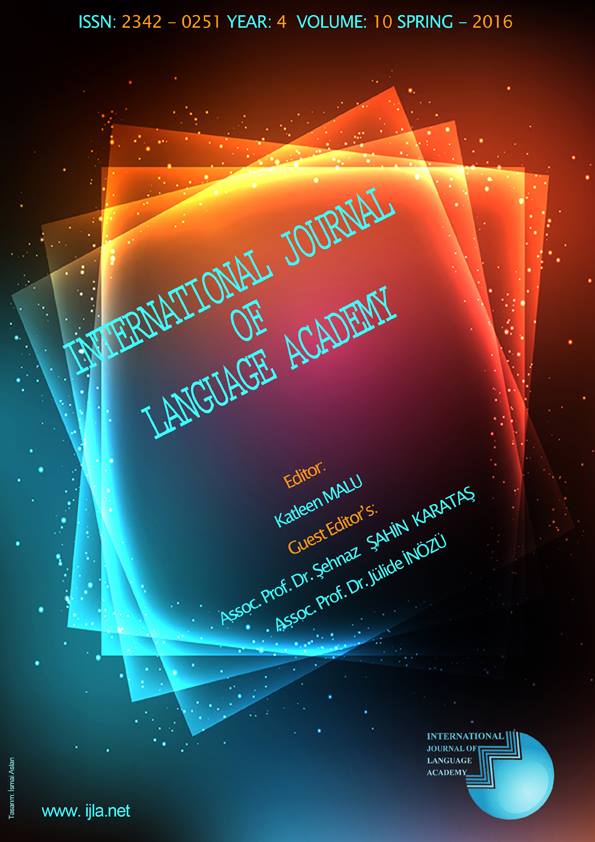Author :
Abstract
Bu araştırma, ortaokul düzeyinde eğitim görmekte olan öğrencilerin yazma motivasyonlarının belirlenmesine yönelik bir ölçme aracı geliştirmeyi amaçlamaktadır. Ölçek; 4 alt boyuttan oluşmaktadır. Bu boyutlar, yazmaya yönelik özyeterlik, duyuşsal durum, sosyal kabul, fiziksel durum olarak sıralanmaktadır. Yazma Motivasyonu Ölçeği’ndeki toplam madde sayısı 28’dir. 3 dereceli Likert tipi olarak hazırlanan bu ölçekten alınabilecek en yüksek puan 84, en düşük puan ise 28’dir.
Keywords
Abstract
This research aimed to develop a tool of measurement in order to determine secondary school students’ motivation for writing. The scale was composed of 4 sub-scales; namely, self-efficacy, affective state, social acceptance, and physical state. The number of items in the Writing Motivation Scale was 28 in total. Therefore, the maximum score receivable from this scale – which was in 3-pointed Likert type- was 84 whereas the minimum score was 28. The four items having a negative meaning in the scale were encoded inversely.
Keywords
- Ackerman, J. (2006). Motivation for writing through blogs. Master of Arts thesis, Submitted. USA: Graduate College, Bowling Green State University.
- Ağca, H. (1999). Yazılı anlatım. Ankara: Gündüz Eğitim ve Yayıncılık.
- Aktas, Ş. & Gündüz, O. (2008). Yazılı ve sözlü anlatım: Kompozisyon sanatı. Ankara: Akçağ Yayınları.
- Akyol, H. (2007). Türkçe ilk okuma yazma öğretimi. (6. Baskı). Ankara: Pegem A Yayıncılık.
- Bandura, A. (1986). Social foundations of thought and action: A social cognitive theory. Englewood Cliffs, NJ: Prentice Hall.
- Binyazar, A. & Özdemir, E. (1980). Yazılı anlatım bilgileri. İstanbul: Milliyet Yayınları.
- Bruning, R. & Horn, C. (2000). Developing motivation to write. Educational Psychologist, 35(1), 25-37.
- Carter, C., Bishop, J. & Kravits, S. L. (2002). Key to effective learning. New Jersey: Printice Hall.
- Cheng, Y. S. (1998). A Qualitative inquiry of second language anxiety: Interviews with Taiwanese EFL students. In J. Katchen ve Y. Liung (Eds.), The Proceedings of the SeventhInternational Symposium on English Teaching (pp. 309-320). Taipei, Taiwan: Crane Publishing.
- Coskun, E. & Tiryaki, E. N. (2013). Writing skills of university students on argumentative text. Hacettepe Üniversitesi Eğitim Fakültesi Dergisi (H. U. Journal Of Education) 28(2),102-115.
- Cüceloğlu, D. (2004). İnsan ve davranışı. İstanbul: Remzi Kitabevi.
- Demirel, Ö. (1999). İlköğretim okullarında Türkçe öğretimi. Ankara: Milli Eğitim Bakanlığı Yayınları.
- Dörnyei, Z. (2001a). The psychology of the language learner. Mahwah. NJ: Lawrence Erlbaum.
- Dörnyei, Z. (2001b). Teaching and researching motivation. In Bess J. L. (ed.) Teaching well and liking it: Motivation faculty to teach effectively. Baltimore: John Hopkins University Press.
- Gambrell, L. B. (2011). Motivation in the schoool reading curriculum. Journal of Reading Education, 5-14.
- Göcer, A. (2010). “Türkçe öğretiminde yazma eğitimi”. Uluslararası Sosyal Araştırmalar Dergisi, 3(12), 178-195.
- Hidi, S. & Boscolo, P. (2006). Motivation and writing (Chapter 10). Edt. Macarthur, C., Graham, S. and Fitzgerald, J., Handbook of Writing Research, New York: The Guilford Press.
- Hidi, S. & Boscolo, P. (2007). Writing and Motivation. Elsevier Publishing.
- Kavcar, C. (1986). Türk Dili. Eskişehir: Anadolu Üniv. Açık Öğretim Fak. Yayınları.
- Kloss, J. D. & Lisman, S. A. (2002). An exposure-based examination of the effects of written emotional disclosure. British Journal of Health Psychology, (7)31–46.
- MacIntyre, P., MacMaster, K. & Baker, S. C. (2001). The convergence of multiple modelsof motivation for second language learning: Gardner, Pintrich, Kuhl and McCroskey. In Z. Dornyei and R. Schmidt (Eds.), Motivation and Second Language Acquisition (pp.461-492). Honolulu, HI: University of Hawaii Press.
- MEB. (2006). Türkçe Dersi Öğretim Programı. Ankara: Talim ve Terbiye Kurulu.
- Nolen, S. B. (2007). Young children's motivation to read and write: Development in social contexts. Cognition and Instruction, 25(2), 219-270.
- Öz, M. F. & Çelik, K. (2007). Uygulamalı İlk Okuma Yazma Öğretimi. (6. Baskı). Ankara: Anı Yayıncılık.
- Özbay, M. (2007). Türkçe Özel Öğretim Yöntemleri II. Ankara: Öncü Kitap.
- Pajares, F. (2003). Self-efficacy beliefs, motivation, and achievement in writing: A review of the literature. Reading & Writing Quarterly, (19), 139-158.
- Petzel, T. P. & Wenzel, M. U. (1993). Development and İnitial Evaluation of Measure of Writing Anxiety. American Psychological Association Convention, Toronto, Canadia.
- Sharples, M. (1998). How we write: Writing as creative design. London, UK: Routledge. Sloan Denise, M., Feinstein Brian, A. & Marx Brian, P. (2009). Durability of beneficial health effects associated with expressive writing. Anxiety, Stress & Coping, 1-15.
- Smyth, J. M. (1998). Written emotional expression: effect sizes, outcome types, and moderating variables. Journal of Consulting and Clinical Psychology, (66) 174-184.
- Şengül, M. (2013). Ortaokul öğrencilerine yönelik “yazma öz yeterlilikleri ölçeği” geliştirme çalışması. Türkiye Sosyal Araştırmalar Dergisi, (171), 81-94.
- Tekindal, S. (2009). Duyuşsal Özelliklerin Ölçülmesi İçin Araç Oluşturma. Ankara: Pegem
- Temur, T., Aksoy, C. C. & Tabak, H. (2012). İlköğretim birinci sınıf öğrencilerinin kalem tutma biçimleri ve kavrama-sıkıştırma kuvvetlerinin yazma hızı ve hatalarına etkisi, Education and Science, (37), 307-319.
- Temur, T. (2011). İlköğretim 1.sınıf öğrencilerinin kalem tutma şekilleri ile kavrama ve sıkıştırma kuvvetlerinin betimlenmesi. Educational Sciences: Theory & Practice, 11(4), 2189-2205.
- Troia, G. A., Shankland, R. K. & Wolbers, K. A. (2012). Motivation research in writing: Theoretical and empirical considerations, Reading & Writing Quarterly: Overcoming Learning Difficulties, 28(1), 5-28.
- Uygun, M. (2012). Öz düzenleme stratejisi gelişimi öğretiminin yazılı anlatıma, yazmaya yönelik öz düzenleme becerisine, kalıcılığa ve tutuma etkisi. Ankara: Hacettepe Üniversitesi Sosyal Bilimler Enstitüsü Yayınlanmamış Doktora Tezi.
- Vaezi, Z. (2008). Language learning motivation among Iranian undergraduate students. World Applied Sciences Journal, 5(1), 54-61.
- Walker, C. J. & Symons, C. (1997). The meaning of human motivation. In J.L.Bess (ed.) Teaching well and liking it: Motivating faculty to teach effectively. (pp. 3-18). Baltimore: John Hopkins University Press.
- Wigfield, A. & Guthrie, J. T. (1995). Dimensions of children's motivationsfor reading: An ınitial study. Athens, GA: National Reading Research Center, College Park, MD.
- Yaman, H. (2010). Writing anxiety of Turkish students: Scale development and the working procedures in terms of various variables. International Online Journal of Educational Sciences, 2(1), 267-289.
